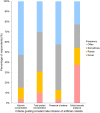Current Trends in Volume Replacement Therapy and the Use of Synthetic Colloids in Small Animals-An Internet-Based Survey (2016)
- PMID: 28929101
- PMCID: PMC5591339
- DOI: 10.3389/fvets.2017.00140
Current Trends in Volume Replacement Therapy and the Use of Synthetic Colloids in Small Animals-An Internet-Based Survey (2016)
Abstract
The use of synthetic colloids (SCs), particularly hydroxyethyl starch (HES), in people has changed in recent years following new evidence raising concerns about their efficacy and safety. Although fluid therapy guidelines for small animals are often extrapolated from human medicine, little information exists on current practice in veterinary medicine. The objective of the present study was to investigate current fluid selection, use of plasma volume expanders including SCs, and recent changes in their use in small animal practice. An Internet-based survey was conducted, inviting veterinarians to report their practices in fluid resuscitation and colloid osmotic pressure support, their choice of SC, and perceived adverse effects and contraindications associated with SC use. There were 1,134 respondents from 42 countries, including 46% general practitioners and 38% diplomates. Isotonic crystalloids, HES, and hypertonic saline were chosen by most respondents for fluid resuscitation, and HES by 75% of respondents for colloid osmotic support. Dextran and gelatin were used by some European respondents. Human serum albumin was used more than canine albumin but 45% of respondents, particularly those from Australia and New Zealand, used no albumin product. The majority (70%) of respondents changed their practice regarding SCs in recent years (mostly by limiting their use), largely due to safety concerns. However, only 27% of respondents worked in an institution that had a general policy on SC use. Impaired renal function, coagulopathy, and hypertension were most often considered contraindications; impaired coagulation tests and increased respiratory rate were the most frequently perceived adverse effects. The use of HES remains widespread practice in small animals, regardless of geographic location. Nevertheless, awareness of safety issues and restrictions on the use of SCs imposed in human medicine seems to have prompted a decrease in use of SCs by veterinarians. Given the paucity of evidence regarding efficacy and safety, and differences in cohorts between human and veterinary critical care patients, studies are needed to establish evidence-based guidelines specific for dogs and cats.
Keywords: dextran; fluid therapy; gelatin; hydroxyethyl starch; plasma expanders; synthetic colloids.
Figures












Similar articles
-
[Volume replacement solutions--pharmacology and clinical use].Anasthesiol Intensivmed Notfallmed Schmerzther. 1998 Jan;33(1):2-17. doi: 10.1055/s-2007-994204. Anasthesiol Intensivmed Notfallmed Schmerzther. 1998. PMID: 9530478 Review. German.
-
The efficacy and safety of colloid resuscitation in the critically ill.Anesth Analg. 2011 Jan;112(1):156-64. doi: 10.1213/ANE.0b013e3181eaff91. Epub 2010 Dec 2. Anesth Analg. 2011. PMID: 21127276 Review.
-
Does small-volume resuscitation with crystalloids or colloids influence hemostasis and survival of rabbits subjected to lethal uncontrolled hemorrhage?J Trauma Acute Care Surg. 2017 Jan;82(1):156-164. doi: 10.1097/TA.0000000000001285. J Trauma Acute Care Surg. 2017. PMID: 27779578
-
Colloids Yes or No? - a "Gretchen Question" Answered.Front Vet Sci. 2021 Jul 2;8:624049. doi: 10.3389/fvets.2021.624049. eCollection 2021. Front Vet Sci. 2021. PMID: 34277747 Free PMC article. Review.
-
Hydroxyethyl starch: a review of pharmacokinetics, pharmacodynamics, current products, and potential clinical risks, benefits, and use.J Vet Emerg Crit Care (San Antonio). 2014 Nov-Dec;24(6):642-61. doi: 10.1111/vec.12208. Epub 2014 Aug 26. J Vet Emerg Crit Care (San Antonio). 2014. PMID: 25158892 Review.
Cited by
-
Biomarkers of Coagulation and Inflammation in Dogs after Randomized Administration of 6% Hydroxyethyl Starch 130/0.4 or Hartmann's Solution.Animals (Basel). 2022 Oct 6;12(19):2691. doi: 10.3390/ani12192691. Animals (Basel). 2022. PMID: 36230433 Free PMC article.
-
Safety evaluation of a buffer used in the lyophilization of canine platelets: type I hypersensitivity reaction in dogs caused by bovine serum albumin.Front Vet Sci. 2024 Feb 12;11:1344037. doi: 10.3389/fvets.2024.1344037. eCollection 2024. Front Vet Sci. 2024. PMID: 38410739 Free PMC article.
-
Assessment of Hydroxyethyl Starch (6% HES 130/0.4) Kidney Storage in Critically Ill Dogs: A Post-mortem Prospective Study.Front Vet Sci. 2022 Jan 6;8:802507. doi: 10.3389/fvets.2021.802507. eCollection 2021. Front Vet Sci. 2022. PMID: 35071392 Free PMC article.
-
Analysis of blood composition by porcine breeding cycle.Vet Med Sci. 2024 Mar;10(2):e31376. doi: 10.1002/vms3.1376. Vet Med Sci. 2024. PMID: 38358072 Free PMC article.
-
Hypocoagulability and Platelet Dysfunction Are Exacerbated by Synthetic Colloids in a Canine Hemorrhagic Shock Model.Front Vet Sci. 2018 Nov 13;5:279. doi: 10.3389/fvets.2018.00279. eCollection 2018. Front Vet Sci. 2018. PMID: 30483517 Free PMC article.
References
LinkOut - more resources
Full Text Sources
Other Literature Sources
Miscellaneous

